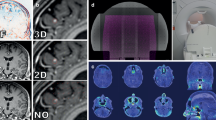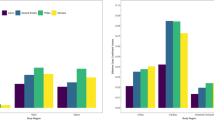Abstract
Gamma Knife® Perfexion™ (PFX) is used for delivering radiosurgery plans to treat lesions and tumours in the brain by means of selectively ionizing the tissue with high-energy beams of radiation. An important component of designing PFX treatments is the selection of points in the target structure at which to focus the radiation, called isocentres. This study applies skeletonization methods to select such isocentres. Our skeletonization technique identifies clusters of each target structure’s skeleton using distance coding methods. A user-defined number of isocentre locations are chosen from the skeletal clusters. The isocentres resulting from this approach are used as input to a sector duration optimization model that determines the optimal shot shapes and intensities for the radiation deposited at each isocentre. The results for seven clinical cases are presented. For each case, target structure dose and conformity meet clinical radiosurgery guidelines, while brainstem dose is kept to acceptable levels and other healthy organs are also spared.




Similar content being viewed by others
References
Arcelli C, Cordella L, Levialdi S (1975) A grassfire transformation for binary digital pictures. In: ICPR74-International Conference on Pattern Recognition, pp 152–154
Bitter I, Kaufman A, Sato Y (2001) Penalize-distance volumetric skeleton algorithm. IEEE Trans Vis Comput Graph 7:195–206
Blum H (1967) A transformation for extracting new descriptors of shape. In: Wathen-Dunn W (ed) Models for the perception of speech and visual form. MIT Press, Cambridge, pp 362–380
Bucksch A, Lindenbergh R, Menenti M (2010) SkelTre-Robust skeleton extraction from imperfect point clouds. Visual Comput 26:1283–1300
Calabi L, Harnett W (1968) Shape recognition, prairie fires, convex deficiencies and skeletons. Am Math Mon 75:335–342
Das IJ, Cheng CW, Chopra KL, Mitra RK, Srivastava SP, Glatstein E (2008) Intensity-modulated radiation therapy dose prescription, recording, and delivery: patterns of variability among institutions and treatment planning systems. J Natl Cancer Inst 100(5):300–307
Elekta (2008) Gamma Knife surgery indications treated December 2008. http://www.elekta.com/healthcare-professionals/products/elekta-neuroscience/gamma-knife-surgery/why-gamma-knife-surgery.html
Ferris M, Lim J, Shepard D (2001) An optimization approach for radiosurgery treatment planning. SIAM J Optim 13:921–937
Flickinger J, Lunsford L, Wu A, Maitz A, Kalend A (1990) Treatment planning for Gamma Knife radiosurgery with multiple isocenters. Int J Radiat Oncol Biol Phys 18:1495–1501
Flickinger JC, Kondziolka D, Lunsford LD, Coffey RJ, Goodman ML, Shaw EG, Hudgins RW, Weiner R, Harsh GR, Sneed PK, Larson DA (1994) A multi-institutional experience with stereotactic radiosurgery for solitary brain metastasis. Int J Radiat Oncol Biol Phys 28:797–802
Ghaffari H, Aleman D, Ruschin M, Jaffray D (2010) An inverse planning approach to Leksell Gamma Knife Perfexion. In: Proceedings of the International Conference on the Use of Computers in Radiation Therapy.
Ghobadi K, Ghaffari HR, Aleman DM, Jaffray DA, Ruschin M (2012) Automated treatment planning for a dedicated multi-source intra-cranial radiosurgery treatment unit using projected gradient and grassfire algorithms. Med Phys 39(6):3134–3141
Herbin M, Bonnet N, Vautrot P (1996) A clustering method based on the estimation of the probability density function and on the skeleton by influence zones: application to image processing. Pattern Recognit Lett 17(11):1141–1150
Klette G (2007) Topologic, geometric, or graph-theoretic properties of skeletal curves. Ph.D. thesis, University of Groningen
Klette G, Pan M (2005) Characterization of curve-like structures in 3D medical images. Commun Inf Technol Res Tech Rep 172:164–175
Lohou C, Dehos J (2010) Automatic correction of Ma and Sonkaős thinning algorithm using P-simple points. IEEE Trans Pattern Anal Mach Intell 32:1148–1152
Molinari F, Mantovani A, Deandrea M, Limone P, Garberoglio R, Suri J (2010) Characterization of single thyroid nodules by contrast-enhanced 3D ultrasound. Ultrasound Med Biol 36:1616–1625
Montanari U (1969) Continuous skeletons from digitized images. J ACM 16:534–549
Nelms BE, Robinson G, Markham J, Velasco K, Boyd S, Narayan S, Wheeler J, Sobczak ML (2012) Variation in external beam treatment plan quality: an inter-institutional study of planners and planning systems. Pract Radiat Oncol 2(4):296–305
Oskoorouchi M, Ghaffari H, Terláky T, Aleman D (2011) An interior-point constraint generation method for semi-infinite linear programming with healthcare application. Operat Res 59:1184–1197
Paddick I (2000) A simple scoring ratio to index the conformity of radiosurgical treatment plan. J Neurosurg 93:219–222
Petti P, Larson D, Kunwar S (2008) Use of hybrid shots in planning Perfexion Gamma Knife treatments for lesions close to critical structures. J Neurosurg 109:34–40
Preteux E (1992) Watershed and skeleton by influence zones: a distance-based approach. J Math Imaging Vis 1(3):239–255
Serizawa T (2009) Radiosurgery for metastatic brain tumors. Int J Clin Oncol 14:289–298
Shepard D, Chin L, DiBiase S, Naqvi S, Lim J, Ferris M (2003) Clinical implementation of an automated planning system for Gamma Knife radiosurgery. Int J Radiat Oncol Biol Phys 56:1488–1494
Shepard DM, Yu C, Murphy M, Bussière MR, Bova FJ (2008) Treatment planning for stereotactic radiosurgery. In: Principles and practice of stereotactic radiosurgery, vol 7. Springer Publishing Company, New York, pp 69–90
Siddiqi K, Pizer S (2008) Medial representations: mathematics, algorithms and applications. In: Computational imaging and vision, p 37
Tran S, Shih L (2005) Efficient 3D binary image skeletonization. In: Proceedings of the 2005 IEEE Computational Systems Bioinformatics Conference Workshops (CSBW’05)
Wadell H (1935) Volume, shape and roundness of quartz particles. J Geol 43(3):250–280
Wagner TH, Yi T, Meeks SL, Bova FJ, Brechner BL, Chen Y, Buatti JM, Friedman WA, Foote KD, Bouchet LG (2000) A geometrically based method for automated radiosurgery planning. Int J Radiat Oncol Biol Phys 48(5):1599–1611
Wang J (1999) Packing of unequal spheres and automated radiosurgical treatment planning. J Combinat Optim 3:453–463
Wang J (2000) Medial axis and optimal locations for min-max sphere packing. J Combinat Optim 4:487–503
Wu Q, Bourland J (2000) Three-dimensional skeletonization for computer-assisted treatment planning in radiosurgery. Comput Med Imaging Graph 24:243–251
Wu Q, Chankong V, Jitprapaikulsarn S, Wessels B, Einstein D, Mathayomchan B, Kinsella T (2003a) Real-time inverse planning for Gamma Knife radiosurgery. Med Phys 30:2988–2995
Wu Q, Wessels B, Einstein D, Maciunas R, Kim E, Kinsella T (2003b) Quality of coverage: conformity measures for stereostatic radiosurgery. J Appl Clin Med Phys 4:374–381
Young R (1998) The role of the Gamma Knife in the treatment of malignant primary and metastatic brain tumors. CA Cancer J Clin 48:177–188
Zhang P, Wu J, Dean D, Xing L, Xue J, Maciunas R, Sibata C (2003) Plug pattern optimization for gamma knife radiosurgery treatment planning. Int J Radiat Oncol Biol Phys 55(2):420–427
Zhou Y, Toga A (1999) Efficient skeletonization of volumetric objects. IEEE Trans Vis Comput Graph 5:196–209
Author information
Authors and Affiliations
Corresponding author
Rights and permissions
About this article
Cite this article
Doudareva, E., Ghobadi, K., Aleman, D.M. et al. Skeletonization for isocentre selection in Gamma Knife® Perfexion™. TOP 23, 369–385 (2015). https://doi.org/10.1007/s11750-014-0344-x
Received:
Accepted:
Published:
Issue Date:
DOI: https://doi.org/10.1007/s11750-014-0344-x




